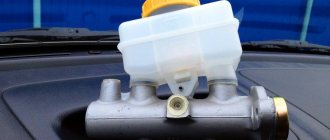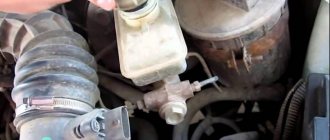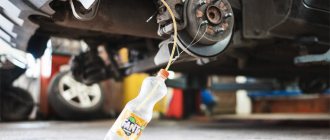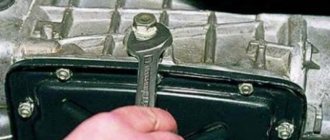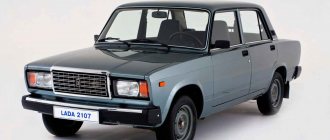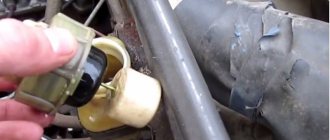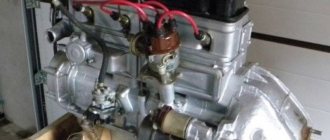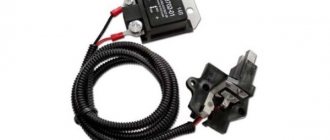Many VAZ 2107 car owners are interested in the question: how much oil should be poured into the main components of the car, such as the engine, gearbox or rear axle? In fact, this information is included in every vehicle operating manual that is issued upon purchase at a car dealership. But if you are the owner of a used vehicle or for some other reason do not know what the main filling capacities of important units are, then this information will be provided in more detail below.
operating fluids used on VAZ 2107 cars
Fuel tank Engine lubrication system
Engine cooling system
Steering gear housing
Hydraulic clutch release system Hydraulic brake system Windshield washer reservoir
Unleaded gasoline with octane number 92 Engine oil: API group: SG, SH, SJ, SL Oil viscosity is selected depending on seasonal fluctuations in ambient temperature. SAE viscosity grade: 10W30 (from -25 °C to +25 °C) 10W40 (from -20 °C to +35 °C) 5W40 (from -30 °C to +35 °C) 0W40 (from -35 °C From up to +30 °C) Coolant: OZhK-K XT; OZH-40-HT, OZH-65-HT, OZHK Antifreeze; OZh-40 Antifreeze; OZh-65 Antifreeze; OZh-40, OZh-65, OZhK-K SK, OZh-40SK, OZh-65SK, Lada-A40; OZH-K Tosol-TS, OZH-40 Tosol-TS; OZh-65 Antifreeze-TS, Antifreeze G-48, AGIP Antifreeze Extra, Glysantin G03, Glysantin G 91 Gear oil: API group: GL-4, GL-5 SAE viscosity grade: SAE75W90; SAE75W85; SAE80W85 Gear oil: API group: GL-5 SAE viscosity grade: SAE75W90; SAE80W90; SAE85W90 Gear oil: API group: GL-4, GL-5 SAE viscosity grade: SAE75W90; SAE80W90; SAE85W90 DOT-4 brake fluid
Brake fluid class DOT-4 Windshield washer fluid: in summer - with detergent additives, in winter - non-freezing, based on various alcohols
Recommended volumes and grades of fuel and lubricants Lada 2107
The VAZ 2107 has been the sales leader on the Russian market for many years. Since its production ceased in 2012, today only a used version can be purchased.
The car is popularly known as the seven. It is a 4-door, 5-month vehicle with rear-wheel drive and a manual transmission. It was produced in several modifications, which differed in engines and restyling.
The manufacturer took into account the peculiarities of Russian roads and created a car that can easily withstand all bumps and potholes. Its ground clearance is quite high, which has a positive effect on cross-country ability. Thanks to rear-wheel drive, the car has excellent maneuverability and good road grip. This is explained simply. When the gas pedal is pressed, weight is transferred to the rear.
The car has two important advantages: affordable cost and low maintenance. There are no problems with purchasing parts, spare parts and consumables. They are presented in a large assortment on the modern market. Moreover, their cost is low.
In addition, the VAZ 2107 boasts a spacious interior, a roomy trunk, comfortable front seats, good visibility, faceless dials and a soft spring suspension that ensures a comfortable ride.
What kind of oil and how many liquids to fill in the VAZ 2107
| Filling/lubrication point | Filling volume, liters | Name of oil/liquid |
| Fuel tank | 39 (42) | Motor gasoline with an octane rating of 92-95″ |
| Engine cooling system including interior heating system | 8,65 | Coolant with a freezing point not higher than -40 C |
| Engine lubrication system, including oil filter, at ambient temperature: from -20 to +45 °С from -25 to +35 °С from -25 to +25 °С from -30 to +35 °C from -30 to +25 °C from -35 to +30 °C | 3,75 | Motor oils (with API quality level: SG, SH, SJ) SAE 15W-40 SAE 10W-40 SAE 10W-30 SAE 5W-40 SAE 5W-30 SAE 0W-40 |
| Gearbox housing | 1,6 | Gear oils with quality level according to API GL-4 or universal GL4/GL5 and viscosity 75W-90, 80W-90 |
| Rear axle housing | 1,3 | Gear oils with quality level according to API GL-5 and viscosity 75W90, 80W-90 |
| Steering gear housing | 0,215 | Gear oil 75W-90 |
| Hydraulic brake system | 0,382 | DOT-4 brake fluid |
| Hydraulic clutch release system | 0,18 | DOT-4 brake fluid |
| Windshield and tailgate washer reservoirs | 2.0 or 5.0 | A mixture of water with a special liquid REVIEW, GLASSOL or windshield washer fluid ASPECT |
| Starter drive drive ring | — | Lubricant Litol-24, AGIP GREASE 30, ESSO UNIREX No. 2 |
| Front wheel bearings | — | Litol-24 lubricant |
| Cardan joint cross bearings | — | Lubricant FIOL-2U, No. 158 |
| Front propeller shaft spline | — | Lubricant FIOL-1, CV joints-4 |
| Door limiters | — | CV joint grease-4 |
| Seat moving slides | — | Lubricant FIOL-1 |
| Tie rod joints and front suspension ball joints | — | ShRB-4 grease |
| Battery leads and terminals, trunk lid torsion bars, door and trunk lid keyholes | — | Automatic lubricant VTV-1 in aerosol packaging, CIATIM-201, -221, Litol-24 |
| Door, hood, trunk lid locks | — | Lubricant FIOL-1 |
| Pressure regulator | — | Grease DT-1 |
PS: Dear car enthusiasts, if you have your own information on this topic, please tell us about it in the comments or write an email to the site administration.
Recommended volumes and brands of fuel and lubricants Lada 2107 was last modified: November 27th, 2022 by Administrator
Refill containers for VAZ 2107
For almost thirty years, the Volzhsky Automobile Plant produced the “Seven” - one of the most common cars in our country. VAZ 2107 is a luxury sedan version of the previous fifth model. By the standards of the end of the last century, the car is quite reliable, comfortable and, most importantly, inexpensive. The technical characteristics of this car were at a fairly high level for its time.
The car was equipped with a one and a half liter gasoline engine, and its tank volume of 39 liters allowed it to travel over 534 km with a minimum consumption of 7.3 liters per 100 km. When driving around the city, this distance decreased to 379 km. The power unit was filled with motor oil, and the crankcases of other mechanisms were filled with special transmission oil. The filling tanks of the VAZ 2107 car had a sufficient volume to ensure trouble-free operation of the engine and other systems.
Reasons for the glowing indicator. Remedies
There are several reasons why the indicator light is on. Let's look at each one separately and how to eliminate them.
Insufficient level
It is quite possible that the engine oil level is insufficient. Every VAZ car owner knows how to check. It is necessary to top up to the permissible level and re-check with starting the internal combustion engine.
Checking the level is carried out on a cold engine or 10 minutes after it has been running.
Internal fault
To check the sensor, you must perform the following steps:
- Turn on the ignition.
- Make sure the indicator lights up.
- Disconnect the wire from the sensor. The indicator should go out.
- “Lock” it with the engine housing. If the indicator on the dashboard lights up, then the wire is working and the cause of the malfunction is in the sensor. It cannot be repaired and should be replaced.
Wiring fault
During vehicle operation, electrical wiring is often exposed to high temperatures, friction with metal parts, drying out, and loss of integrity.
The check is carried out according to the electrical diagram of the VAZ 2107 car using a multimeter for conductivity and resistance of the wire.
Wear of engine parts
During operation of the internal combustion engine, oil circulates through its piston system and gas distribution mechanism through special channels. If the rubbing parts wear out, the tightness and alignment of these channels is disrupted. Due to this, the pressure drops.
The solution to this problem is to overhaul the engine.
Pump fault
In this case, the oil pressure in the line is checked using a pressure gauge.
A pressure gauge must be screwed into the technical hole in the internal combustion engine cylinder block for the sensor and the internal combustion engine must be started. At idle speed the value should be about 1.5 kg/cm2. As the engine speed increases, the pressure should increase, reaching 5–6 kg/cm2.
Operating standards for technical fluids
Already at the development stage, the manufacturer determines the parameters of the machine, which are refined during the testing process. So, in the described car, model VAZ 2107, the volume of the fuel tank corresponds to the size of the niche in the trunk behind the right wheel arch. Crankcases of other mechanisms contain the following quantities of operating fluids:
- engine – 3.75 liters of engine oil;
- cooling jackets, radiator and expansion tank - 9.85 liters of antifreeze;
- manual gearbox housing – 1.35 liters of TAD-17 oil;
- rear axle - 1.3 liters of the same oil;
- hydraulic clutch – 0.2 l of brake fluid;
- steering gear housing – 0.215 l of hypoid oil;
- closed container for windshield washer - 2 liters of water or special liquid.
Operating standards for the VAZ 2107 car were developed by the manufacturer for organizations and enterprises. Knowing the volume of fuel that the tank or crankcases of other mechanisms hold, it is easy to calculate the amount required for travel.
Where is the sensor located
The most common places where it is found are near the oil filter, in the upper part of the engine near the camshaft block, or pump.
Let's look at specific models:
- VAZ 2108/09/099. Located on the top right side of the engine (when viewed in the direction of travel) next to the timing belt cover. There is only one wire coming from it. This arrangement is also typical for 8-valve engines on the VAZ 2110/11.
- VAZ 2110/11 16 valve engine. Located on the left side of the engine (when viewed in the direction of travel) on the driver's side on the camshaft block between the air filter, ignition module and oil filler neck.
- VAZ 2112, 16-valve engine. It is located on the top left side (look along the way). To find it you need to remove the air filter.
- VAZ 2114. Located on the right inner side of the engine on the cylinder head next to the timing belt. It is clearly visible from above. To dismantle it, remove the protective cap, the terminal and turn it out with a 21 key.
- Lada Kalina. Located on the right rear of the engine near the timing belt, one wire comes from it. To get to it you need to remove the plastic cover of the cylinder block.
- Lada Priora. Located on the left (when viewed along the way) on top of the cylinder block under the intake air manifold. To dismantle it, you must first remove the protective plastic cover of the engine, move the air manifold and unscrew it with a 21 mm socket wrench. It sits very tight.
- Lada Granta 8 and 16 valve engine. Located on the top right side of the engine near the timing belt cover. To remove it, you can use a spark plug wrench or a 21 open-end wrench.
- GAZ "Gazelle" (engine ZMZ-405). Located on the BC, top right. There is only one wire coming from it.
The most common wrench size for removing the sensor is 21. You can use a spark plug wrench. But it all depends on the specific brand of car.
After the pressure sensor has been removed, the seat is tightly covered with a clean rag so that dirt does not get there and oil does not leak out during possible engine operation.
It would be a good idea to measure the oil pressure in the system at idle, medium and high speeds. To do this, use a pressure gauge, which is screwed in instead of the DDM
To take accurate readings, it is important to ensure a tight connection
For each car model, the values may differ. These can be found in the instruction manual.
For example, for a VAZ 2112 there are 16 valves, the standard engine oil pressure is:
- at idle speed 2 BAR.
- at 5 thousand revolutions from 4.5 to 6.5 BAR.
If all the readings are normal and the light is constantly on, then the information does not reach the ECU or gets distorted. This may be due to the sensor, which needs to be checked.
Possibilities for upgrading the machine
In the nineties of the last century, many owners of VAZ 2107 cars, not particularly counting on gas stations, installed an additional tank in the car. This is much more convenient than pouring fuel from cans. Typically, such a container was located behind the rear seat in the trunk. It could have different sizes, and accordingly they had the appropriate capacity.
The driver in those days often encountered empty gas stations, and the additional volume of the fuel tank greatly expanded the capabilities of the car. Knowing the required amount of technical fluids is necessary for routine maintenance of the engine and other systems.
When is brake fluid replacement necessary?
Many motorists simply top up the brake fluid, without particularly paying attention to either the recommendations from the service book or the objective signs of deterioration in braking efficiency. Meanwhile, a complete replacement of the fluid cannot be avoided if its level has dropped below the minimum mark and the corresponding symbol lights up on the instrument panel.
Of course, you can simply add fluid, but after that it is worth checking the serviceability of the brakes, since a drop in the level indicates a malfunction in the master cylinder or the fuel fluid supply system to the wheels.
VAZ-21074 injector: the last of the “classics”
The latest classic version of the Zhiguli was the VAZ-21074, which later became one of the most popular Soviet and then Russian cars. The VAZ-21074 injector was greeted by numerous admirers of the “seventh” model with undisguised enthusiasm, and, by and large, the car as a whole met the expectations of car enthusiasts. At the time of release, the car was considered the fastest rear-wheel drive sedan of the models previously produced by the Volzhsky Automobile Plant. In 2006, in order to comply with environmental safety conditions and improve technical parameters, an injection engine began to be installed on the VAZ-21074.
Review of Manufacturer Prices
| DOT5.1 250ml TRW PFB525 | From 180 |
| DOT4 500ml TRW PFB450 | From 220 |
| DOT5.1 500ml TRW PFB550 | From 220 |
| DOT5.1 ESP 500ml TRW PFB750 | From 220 |
| DOT4 1L TRW PFB401 | From 220 |
| DOT5.1 1L TRW PFB501 | From 220 |
| DOT4 ESP 1L TRW PFB440 | From 220 |
| DOT4 ESP 1L TRW PFB440 | From 220 |
| DOT4 5L TRW PFB405 | From 220 |
| *prices are as of May 2022 | |
Review of the VAZ-21074 injector model
The beginning of serial production of VAZ-21074 cars dates back to 1982, when the first copies of this model rolled off the assembly line of the Volzhsky Automobile Plant. At that time, the car was equipped with a carburetor power system: the injector on the VAZ-21074 appeared only in 2006. The advantages of the injection method of fuel supply are no longer a revelation to anyone, and after this system was implemented on the VAZ-21074:
- the engine began to start better in conditions of negative temperatures, without requiring prolonged warm-up;
- at idle speed the engine began to operate more smoothly and quietly;
- fuel consumption has decreased.
The disadvantages of the VAZ-21074 include:
- low location of the exhaust pipe catalyst, which increases the risk of damage to this expensive part;
- inaccessibility of some parts and sensors, which was a consequence of the fact that the old type of body was not designed for an injection system - in the carburetor version there is much more space under the hood;
- low level of noise insulation, which reduces the level of comfort of the car.
The presence of a computer control unit allows you to respond in a timely manner to the occurrence of malfunctions, since a signal about a breakdown is immediately sent to the instrument panel. The control circuit for the operation of the engine and its systems used in the VAZ-21074 allows you to control the composition of the fuel mixture, turn the fuel pump on and off using electronics, and continuously monitor all components and mechanisms.
The control scheme includes:
- Motor diagnostic block;
- Tachometer;
- Control system fault monitoring lamp;
- Throttle sensor;
- Throttle valve;
- Radiator cooling fan;
- Fan relay;
- Control block;
- Ignition coil;
- Speed sensor;
- Ignition section;
- Temperature sensor;
- Crankshaft sensor;
- Fuel pump relay;
- Fuel tank;
- Gasoline pump;
- Bypass valve;
- Safety valve;
- Gravity valve;
- Fuel filter;
- Canister purge valve;
- Reception pipe;
- Oxygen sensor;
- Battery;
- Egnition lock;
- Main relay;
- Nozzle;
- Fuel pressure control;
- Idle air control;
- Air filter;
- Air flow sensor.
A plate with identification data of the VAZ-21074 car can be found on the bottom shelf of the air intake box, which is located under the hood near the windshield, closer to the passenger seat. Next to the plate (1) is stamped VIN (2) - the vehicle identification number.
The passport data on the plate is:
- Parts number;
- Manufacturing plant;
- Indication of conformity and vehicle type approval number;
- An identification number;
- Power unit model;
- Maximum permissible force on the front axle;
- Maximum permissible load on the rear axle;
- Version and equipment;
- Maximum permitted vehicle weight;
- Maximum permitted weight with trailer.
The alphanumeric characters on the VIN number mean:
- the first three digits are the manufacturing plant code (in accordance with international standards);
- the next 6 digits are the VAZ model;
- Latin letter (or number) - year of manufacture of the model;
- the last 7 digits are the body number.
Why does it flow
There are many options for why coolant may leak. It is very difficult to determine this location of the leak. The main ones are:
- View all pipes; perhaps one of the clamps is not clamped properly.
- The pipe itself has cracked from time to time.
- The cause of mechanical damage is in the radiator. This can be corrected by welding or gluing. You can determine the location of the leak in the radiator using dismantling or gel sealant.
- Water pump. Over time, the pump, like any other part, can wear out and leak. In this case, the pump will have to be replaced.
- The element leaks out from under the head. It is better to correct such a leak at a service center, since this will require disassembling the engine.
- When the element leaks directly into the vehicle's cabin. This can be determined by lifting the floor mat on the driver or passenger side.
Technical characteristics of VAZ-21074 injector
The most significant feature of the VAZ-21074 model that appeared in the early 80s, which distinguished it from other modifications of the “seven”, was its equipment with a 1.6-liter VAZ-2106 engine, which initially only ran on gasoline with an octane rating of 93 or higher . Subsequently, the compression ratio was lowered, which made it possible to use lower grade fuel.
Table: technical characteristics of VAZ-21074
The dynamic performance of the VAZ-21074 is inferior to most budget foreign cars, but domestic car enthusiasts appreciate the “seven” for other qualities: spare parts for the car are inexpensive and publicly available, even a novice driver can repair almost any component and unit on his own. In addition, the machine is extremely unpretentious and adapted for operation in Russian conditions.
Video: the owner of a VAZ-21074 injector shares his impressions of the car
The engine from the VAZ-2106 was installed on the VAZ-21074 without changes: among other things, the camshaft chain drive was left, which, compared to the belt drive (used in the VAZ-2105), is more durable and reliable, although noisier. There are two valves for each of the four cylinders.
Compared to previous models, the gearbox has been noticeably improved, featuring a fifth speed with a ratio of 0.819. The gear ratios of all other speeds have been reduced in relation to previous analogues, as a result of which the gearbox operates more “softly”. The rear axle gearbox, borrowed from the 6, is equipped with a self-locking differential with 22 splines.
The DAAZ 2107–1107010–20 carburetor, which was installed on the VAZ-21074 until 2006, established itself as a fairly reliable mechanism, which, however, was very sensitive to fuel quality. The appearance of the injector added to the attractiveness of the model, thanks to new capabilities: now it was possible, by reprogramming the control unit, to change the engine parameters - to make it more economical or, conversely, powerful and responsive.
The front pair of wheels has an independent suspension, the rear one has a rigid beam, making the car quite stable when cornering. The fuel tank holds 39 liters and allows you to travel 400 km without refueling. In addition to the fuel tank, the VAZ-21074 is equipped with a number of other refueling tanks, including:
- cooling system, including a radiator, engine cooling jacket, expansion tank. The system is filled with coolant with a volume of 9.85 liters;
- 5-speed manual transmission housing - 1.35 liters of TAD-17 oil;
- engine crankcase - 3.75 liters of engine oil;
- rear axle - 1.3 liters of TAD-17 oil;
- steering column housing - 215 ml hypoid oil;
- windshield washer - 2 liters of liquid;
- hydraulic clutch - 200 ml of brake fluid.
For the anti-corrosion coating of the bottom, polyvinyl chloride plastisol D-11A is used. Having a maximum speed of 150 km/h, the car accelerates to “hundreds” in 15 seconds. From its closest predecessor, the “five,” the VAZ-21074 received a brake system and a similar appearance. The two models differ:
- shapes of the trunk and hood;
- radiator grilles;
- rear lights;
- chrome trim on the bumpers.
Elimination of illiteracy
If you are interested in what kind of oil the engineers of the Volzhsky Automobile Plant recommend to fill into the power units of classic Lada cars - mineral, semi-synthetic or synthetic, then you are formulating the question incorrectly. The manufacturer's recommendations relate only to the quality standards that the engine oil being poured must meet.
Many people notice that product canisters usually have markings like API SH or API SJ/CF
You should pay attention to it first of all, since it is this marking that informs about the quality of the product
API is an acronym for the American Petroleum Institute. This institute checks whether motor oil meets certain quality standards based on a large number of indicators, including:
- the amount of deposits remaining on engine parts after a standard period of operation;
- washing ability;
- temperature characteristics;
- toxicity;
- corrosivity;
- effectiveness of protecting engine parts from friction.
The abbreviations SJ or CF are deciphered as follows.
- S and C are the categories of engines for which the oil is intended. Lubricants for gasoline power units are designated by the letter S, and lubricants for diesel engines by the letter C.
- J and F – quality of oil performance characteristics. The farther the letter is from A in alphabetical order, the higher the product characteristics.
Engineers at the Volzhsky Automobile Plant require that the engine of the VAZ 21074 injector be filled with lubricant that at least meets the API SG/CD standard. Moreover, if you come across a product that meets the API SH, SJ or SL standard, then it is better to fill it.
Recommended VAZ 2107 oils according to SAE classification:
- Lukoil Lux – 5W40, 10W40, 15W40.
- Lukoil Super - 5W30, 5W40, 10W40, 15W40.
- Novoil-Sint – 5W30.
- Omskoil Lux – 5W30, 5W40, 10W30, 10W40, 15W40, 20W40.
- Norsi Extra – 5W30, 10W30, 5W40, 10W40, 15W40.
- Esso Ultra – 10W40.
- Esso Uniflo – 10W40, 15W40.
- Shell Helix Super – 10W40.
Salon VAZ-21074
The design of all modifications of the VAZ-2107 family (including the VAZ-21074 injector) provides for the arrangement of components and assemblies according to the so-called classical scheme, when the rear wheels are driven and the engine is shifted forward as much as possible, thereby ensuring optimal weight distribution along the axles and, as a result, improving vehicle stability. Thanks to this arrangement of the power unit, the interior turned out to be quite spacious and was located inside the wheelbase, i.e., in the zone of best ride smoothness, which could not but affect the comfort of the car.
The interior trim is made of high-quality non-glare materials. The floor is covered with mats made of non-woven material on a polypropylene base. The body pillars and doors are upholstered in semi-rigid plastic, covered on the front side with caprovelor; velutin is used for seat upholstery. The ceiling is finished with polyvinyl chloride film with a duplicated foam pad, glued to a base formed from plastic. Through the use of various mastics, layered bitumen gaskets and felt inserts:
- heat and sound insulation of the interior is achieved;
- vibration is eliminated;
- Metal components are protected from corrosion.
Video: how to improve the VAZ-21074 injector
The front seats have adjustable reclining backrests that can be moved on slides to achieve the most comfortable seating position. The rear seats are fixed.
The instrument panel of the VAZ-21074 consists of:
- Voltmeter;
- Speedometer;
- Odometer;
- Tachometer;
- Coolant temperature indicator;
- Econometer;
- Warning lamp block;
- Daily mileage indicator;
- Fuel level control lamps;
- Fuel level indicator.
When I sat down and drove off, at first I was completely confused, before that I had driven foreign cars, but here the steering wheel is twisted too tightly to press the pedal, probably the strength of an elephant is needed. I arrived, immediately drove it to a hundred, it turned out that the oil and filters in it had not been changed at all, so I changed it. Of course, it was difficult to drive at first, although the engine and gearbox suited me initially. Then it happened that I had to go far away, I almost turned gray on this trip. After 80 km I could no longer feel my back, nor my legs either; I was almost deaf from the endless roar of the engine, and when I refueled at an unknown gas station, it almost stopped altogether. I got there with no luck, I went to clean the fuel system, but they looked, they say the car is in good condition, they just haven’t modernized the rear-wheel drive since the Soviet Union. They conjured something, re-flashed it, shoved in something that couldn’t be shoved in, but the fact emerged: consumption decreased significantly, and the power was added to the machine. For this repair I paid 6 grand, there was only one more repair, when the windshield was broken with a stone, and it bounced off and left a dent on the hood, and I paid another thousand. In general, once I got used to it, everything became normal. I think the car is worth the money, the car is reliable, and there are no problems with spare parts. The most important thing is to take care of the car, change everything on time and not delay it even with a burnt-out light bulb, otherwise the consequences can lead to who knows what.
Efim
https://rauto.club/otzivi_o_vaz/156-otzyvy-o-vaz-2107-injector-vaz-2107-inzhektor.html
The gear shift pattern of a 5-speed gearbox differs from a 4-speed gearbox only in that a fifth speed has been added, to engage which you need to move the lever all the way to the right and forward.
The use of an injection fuel supply circuit in the VAZ-21074 car adds technology to the vehicle, allows you to save gasoline and control the volume of mixture supplied to the engine using electronics. Despite the fact that the model has not been produced since 2012, the VAZ-21074 continues to be in demand in the secondary market, thanks to its more than affordable price, ease of maintenance, and adaptability to Russian roads. The exterior of the car is quite easy to tune, due to which the car can be given exclusivity and its design made more relevant.
Types of DDM
Oil pressure sensors are divided into two types:
- Mechanical. They are used on cars that have become legends in the automotive industry, in particular, VAZ 2101, UAZ, Moskvich 401/407/412/, 2141 and others.
- Electronic. Installed on all modern cars, for example, domestic VAZ 2114, Kalina and other Lada models, as well as foreign cars.
Mechanical sensors
Mechanical sensors by design are divided into:
- Devices with two rods and a capillary tube.
- Devices with a rheostat.
The first ones consist of a body, a membrane, two rods, and a sealed tube.
As the pressure in the lubrication system increases, the membrane bends, putting pressure on the first rod, thereby increasing the pressure in the tube. The second rod takes this pressure and transmits it to the differential pressure gauge (located on the instrument panel).
The pressure increases - the arrow of the device deviates in a larger direction, falls - the arrow goes down to the left. The principle of operation is the same as that of a pressure gauge.
The mechanical oil pressure sensor with rheostat consists of:
- Cases.
- Membranes.
- Slider.
- Nichrome winding (resistor).
The device operates on the principle of a voltmeter. The rheostat and slider play a key role here.
The rheostat changes its resistance depending on where the slider is moved. The latter, in turn, shifts in one direction or another as the membrane bends or straightens.
When there is no pressure, the membrane is not deformed and the slider does not move, the current passes freely without encountering any resistance along its path.
As the pressure increases and the membrane deforms, the slider moves along the rheostat, thereby increasing the resistance in the circuit; accordingly, the current readings change, which is displayed on the device in the driver’s cabin.
All this is recorded by the ECU, to which the sensor is connected. It is programmed in such a way that only one period of current values is equal to the standard oil pressure. Exceeding this interval is equivalent to an incorrect value.
This is clearly visible on dial analog pressure gauges, which, in fact, are ordinary voltmeters.
Electronic sensors
Electronic DDM is much simpler than its mechanical counterpart, so it is considered more reliable.
Essentially, this is an emergency sensor that does not show the pressure in the system, but only notifies the driver when it is within normal limits and when it is not.
Principle of operation. When pressure is not applied to the sensor membrane, it is not deformed. The rod is in a position in which the circuit contacts are closed and current flows through them. At this moment, a lamp is lit in the cabin, which is monitored by the driver.
When the engine starts, the oil pressure in the system increases, the membrane bends, the rod moves, opening the circuit. The light goes out.
If after starting the engine the lamp does not go out within 1-2 seconds, you must immediately turn off the engine and do not start it until the cause of the malfunction is determined.
Read more here - what to do if the oil pressure lamp is on https://autotopik.ru/remont/1062-gorit-lampa-davleniya-masla.html.
Based on the above, we can conclude that the basis for checking the oil pressure sensor on modern cars is measuring the resistor resistance with a multimeter and checking the DDM for opening and closing the circuit.
To do this, the multimeter is switched to resistance or continuity measurement mode. It depends on what type of sensor is being tested with or without a resistor.
But there are other verification methods, which we will discuss below.
How much liquid and what oils are filled in LADA (VAZ-2107)
Lada VAZ 2107 is a domestic car with a long history. Despite the great competition, it does not give up its position and occupies a leading position in sales in the secondary market. Today, almost two million Russians own a S7.
The car is presented in a sedan body. Rear-wheel drive. The gearbox is mechanical. There are ten modifications. Their main differences are in power plants and restyling.
Refill tanks for VAZ 21074 injector
After purchasing a car, many novice car owners ask a number of questions regarding fuels, lubricants and operating fluids.
Even “experienced” drivers are not always confident in the correct maintenance of their car, and therefore turn to various books and other sources for the necessary information. Some people ask car dealers for advice, and they, in turn, use special manuals and applications for a particular make and model of car to answer their questions.
The table below contains basic information on the lubricants, operating fluids and fuel (gasoline) used, and also provides data on the locations and volumes of refueling for VAZ 2101, 2102, 2103, 2104, 2105, 2106, 2107 or simply “ classic ” cars.
Here you can find answers to the following questions:
- What is the car's gas tank capacity?
- What kind of gasoline should I use?
- What kind of engine oil should I pour into the engine, oil volume?
- What kind of transmission oil should I pour into the box, rear axle? What is the volume of the crankcases?
- The difference in the volume of a 4 and 5 speed gearbox?
- What is the volume of the brake system? Clutches?
- What brake fluid should I add?
- What fluid or oil should I pour into the front and rear shock absorbers?
- What is the filling volume of the cooling system? What coolant should I use?
- Recommended windshield washer fluid? Washer reservoir volume?
- What lubricant should I use for bearings, ball joints, steering rods?
- How to lubricate hinges, door locks, battery terminals?
This is a reminder for drivers of the VAZ 2107 (also relevant for other classics), I decided to create it because minor technical questions often arise, and it takes a lot of time to find the answer. And here everything is in one place. Save this reminder in your bookmarks or on your page on a social network, and use the social network buttons under the article for your health.
Antifreeze volume in the car
The first thing you need to know is how much antifreeze can be poured into a VAZ 2107 so that it works stably. For cars of brands such as VAZ 2101, 2105, 2106 and VAZ 2107, the volume of fluid is the same - 9.85 liters, it must be replaced every two years.
Replacing antifreeze on a VAZ 2107 occurs in the following way:
- The first thing you need to pay attention to is the cooling system; if it is clogged, it needs to be washed with special products or water.
- Next, you need to take a spanner wrench and a container of at least ten liters to drain the old car fluid. It is very important that the radiator is cold when replacing, since antifreeze is a harmful substance, and when heated it also becomes very toxic.
The volume of coolant in a VAZ 2107 can reach up to ten liters. Antifreeze is suitable for the engine cooling system, as it prevents heat from entering the engine and cools the radiator. The cooled antifreeze is moved to the car engine using a pump. This process continues until engine operation stops. During operation, antifreeze heats up and loses its positive properties, so it must be changed periodically. The process of heating the antifreeze occurs when the car travels a distance of about 60 thousand kilometers.
Operating standards for technical fluids
Already at the development stage, the manufacturer determines the parameters of the machine, which are refined during the testing process. So, in the described car, model VAZ 2107, the volume of the fuel tank corresponds to the size of the niche in the trunk behind the right wheel arch. Crankcases of other mechanisms contain the following quantities of operating fluids:
- engine – 3.75 liters of engine oil;
- cooling jackets, radiator and expansion tank - 9.85 liters of antifreeze;
- manual gearbox housing – 1.35 liters of TAD-17 oil;
- rear axle - 1.3 liters of the same oil;
- hydraulic clutch – 0.2 l of brake fluid;
- steering gear housing – 0.215 l of hypoid oil;
- closed container for windshield washer - 2 liters of water or special liquid.
Operating standards for the VAZ 2107 car were developed by the manufacturer for organizations and enterprises. Knowing the volume of fuel that the tank or crankcases of other mechanisms hold, it is easy to calculate the amount required for travel.
Possibilities for upgrading the machine
In the nineties of the last century, many owners of VAZ 2107 cars, not particularly counting on gas stations, installed an additional tank in the car. This is much more convenient than pouring fuel from cans. Typically, such a container was located behind the rear seat in the trunk. It could have different sizes, and accordingly they had the appropriate capacity.
The driver in those days often encountered empty gas stations, and the additional volume of the fuel tank greatly expanded the capabilities of the car. Knowing the required amount of technical fluids is necessary for routine maintenance of the engine and other systems.
Sources:
https://car-exotic.com/vaz-cars/vaz-lada-2107-car-supplement-3.html https://7vaz.ru/ustrojstvo/zapravochnye-emkosti.html https://bumper.guru/ klassicheskie-modeli-vaz/poleznoe/vaz-21074-inzhektor.html https://alians-avto96.ru/raznoe/zapravochnye-obemy-vaz-2107-inzhektor.html https://o-ladagranta.ru/zapravochnye- emkosti-vaz-21074-inzhektor/
